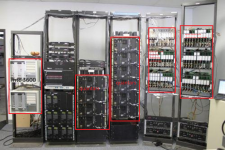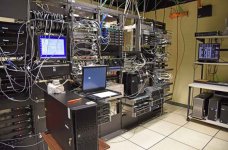View attachment 148069
(1) what is the bare minimum for a smartnet system to operate?
Central controller and 2 repeaters (one for control channel, one for voice traffic). Would be a pointless system with one voice path, but that is the "minimum"
(2) what did a typical smartnet/smartzone/type 2 rack look like (device model numbers, what routers/computer/radios/specialized devices/ present?)
As has been mentioned, that was a LONG time ago and I don't remember. The repeaters were usually stacked 3 high for the MSF-5000's, that included their respective power supplies.
The Central Controller was a half height cabinet. I recall the card cage and a pair of modems that connected back to the CEB (primary and backup links), along with a dial up modem for administration. I do recall a UPS just for the central controller. May have been more, but that was memory from about 15 years ago before I shut our smoldering pile of leaky capacitors down.
(3) what/were any software components and what did they do? (often called "astro core" on p25, but i dont know what its called in this)
On a SmartNet system, it was all in the central controller and you modemed in to a terminal prompt for administration/subscriber access control.
(4) what is the difference between smartzone, smartnet, and type 2 (anything to add beyond this thread:
Smartnet vs SmartZone)
Type 2 was the trunking protocol, there was a Type 1. I think we actually ran 2i.
SmartNet was a basic single site, as I remember.
SmartZone was multisite.
(5) how did amss work? how did it select signals? what parameters?
I had a SmartNet system, so we didn't use AMSS, but as I recall, AMSS was a way for the radio to choose the correct radio site based on signal strength
.
(6)when was type 2/smartzone and smartnet in use? i think ive heard of some in use right now!
Ours was put in around the early 1990's. Probably many in the late 1980s. I've heard that there are still some in use, but they have no doubt been updated since the 1990's. A lot of the Motorola gear back in that time frame was notorious for leaky electrolytic capacitors that would absolutely destroy the circuit boards. When I shut our system down, the central controller was unreliable and would frequently crash because of this, as well as failed memory retention batteries. A real s**t show of a system. I doubt anyone is still running one of those older systems because of that issue.
I e-wasted ours. No one wanted it, no one wanted to take that on. None of the equipment was reliable anymore. Wasn't worth much other than scrap value.
(7) what equipment is shown here, beyond what ive identified?
No idea, some of it looks familiar, but those memories have been long since replaced with much more modern equipment. Your photo looks like a much newer system.
(8)other general information is nice
(9) yes, i used my previous thread a cookie cutter template for this.
These were Motorola's attempt at the Project 16 "standard". Ours was analog and worked OK for a while.
The MSF-5000 repeaters would usually not stay on frequency for very long. The joke was MSF stood for Might Stay on Frequency". Most people that retained their systems upgraded to Quantars.
Towards the end, our MSF-5000's needed realignment about every month, and sometimes that wasn't even enough. I'd often have to take repeaters off line because they became unusable.
Very little in the way of system security, they were easy to hack.
System keys were easily faked.
Ours was analog only. 5 channels, one control channel, 4 voice channels.
I was very glad to see it go.
Any more information is going to be costly and unreliable due to age.
Hopefully you are not seriously thinking about buying one of these things?




